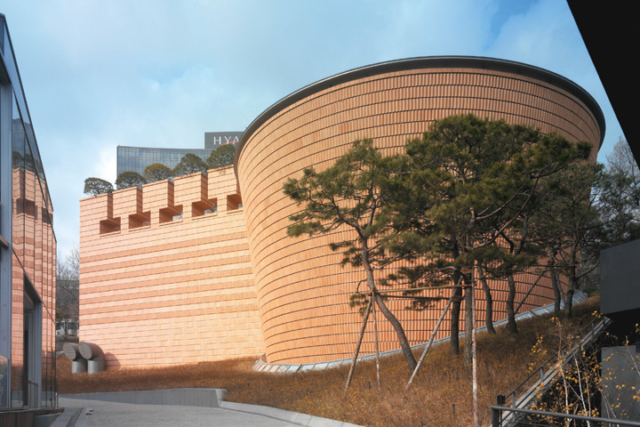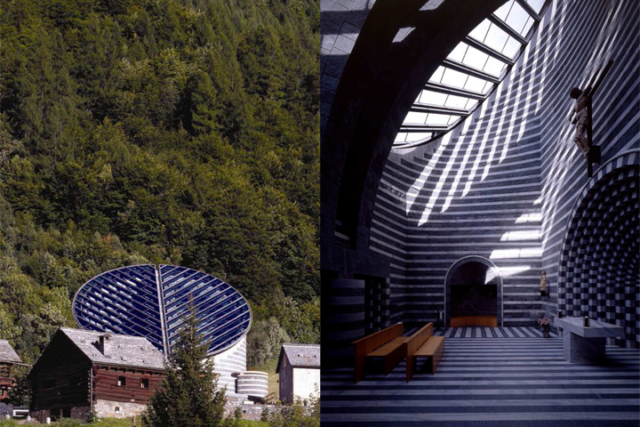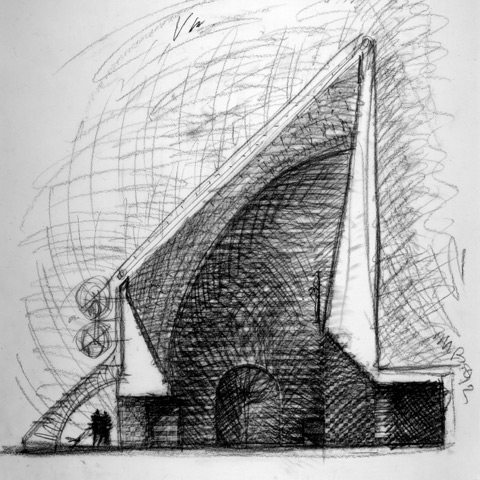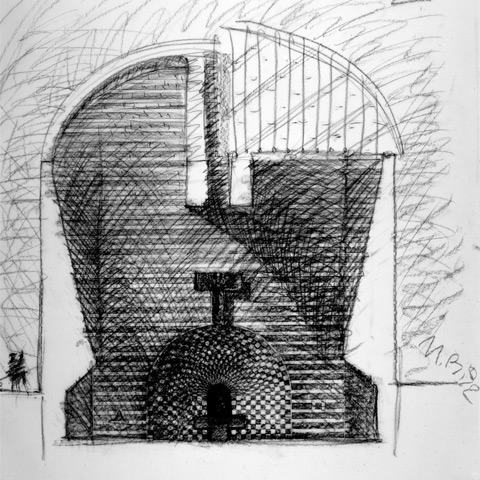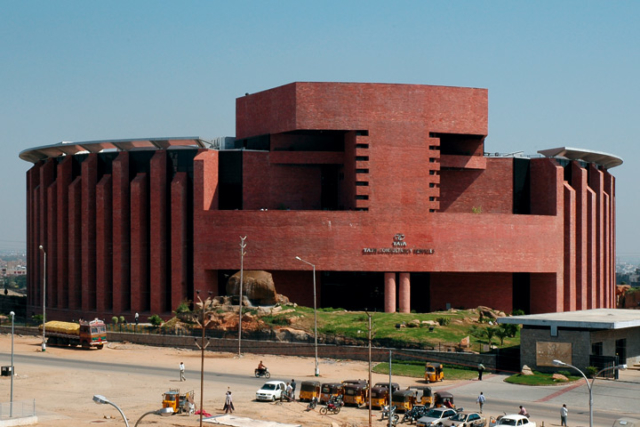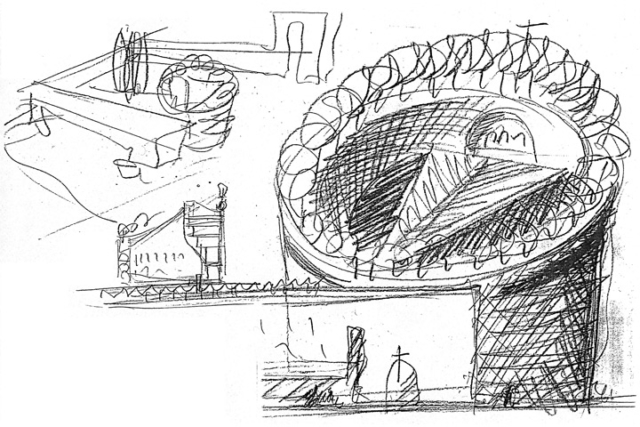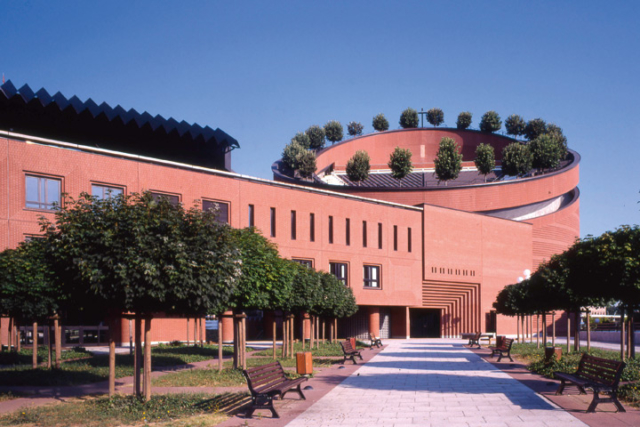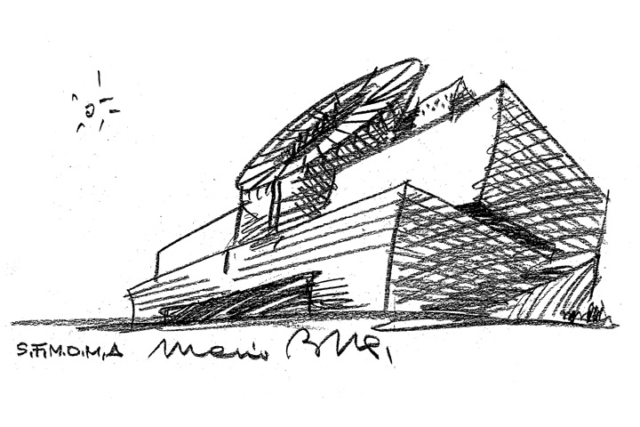U decembru prošle godine smo zamolili arhitektu Maria Botu da nam pošalje svoje crteže koje je radio tokom prethodnih godina za svoje objekte. Ideja da objavimo te crteže mu se dopala, tako da imate priliku da ih vidite.
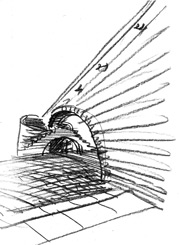 Ovako nastavljamo praksu započetu u ranijim brojevima, kada smo objavili akvarele Stivena Hola, pa nakon toga crteže Ričarda Mejera.
Ovako nastavljamo praksu započetu u ranijim brojevima, kada smo objavili akvarele Stivena Hola, pa nakon toga crteže Ričarda Mejera.
Interesantna karakteristika Botinih crteža je velika sličnost konceptualnih crteža sa realizovanim delima, što dokazuje njegovu izuzetnu imaginativnu sposobnost. Crtežima dominira forma, ali se na crtežima jasno raspoznaje izuzetan osećaj za teksturu koju će kasnije, kroz projekat, objekti dobiti.
Izabrali smo najinteresantnije crteže bez osvrtanja na to kada su nastali.
LEEUM – SAMSUNG MUZEJ UMETNOSTI U SEULU, KOREJA 1995-2004
Merloni na vrhu građevine postavljene na najvišem delu brda stvaraju arhaičnu siluetu na granici sa nebom. Istovremeno, zarubljena, kupasta kosina ukorenjena u zemlju, naglašava slike novog prostora iskopanog iz utrobe brda. U ovu površinu obloženu ciglama, dnevna svetlost prodire i igra na površinama, osvetljavajući spiralni cirkulacioni sistem koji vodi do različitih nivoa izložbenog prostora. Zahvaljujući ovom svetlosnom levku, izložbeni put je uvek povezan sa velikim prilaznim prostorom na najnižem nivou građevine. Arhitektonski pristupi u obradi površina dva prostora, komplementarni su sa izmenama horizontalnih veza, prvobitno planirano da budu od betona i kamena, ali u konačnom dizajnu promenjenim u cigle, da bi se postigao nameravani efekat spajanja, neznatno drugačiji u svakom prostoru.
WELLNESS CENTAR “BERGOASE”, AROSA, ŠVAJCARSKA 2003-2006
Arosa nudi izuzetnu geografsku konfiguraciju kotline okružene planinama. Gradilište za nov objekat Berg Oase pored hotela je okarakterisan kao otvoren prostor i park na korak od neobične planine. „Osmislili smo gradnju bez građenja, da bismo predstavili prisustvo novog, kroz delove, koji se izdižu (veštačko drveće kao metafora prirode) i da ostavimo veliki prostor sa funkcionalnim programom. Pokrivač podzemnog prostora postaje scena okvirena prisustvom vegetacije koja budi radoznalost posetilaca. S’ toga, ovaj sadržaj nam je nametnuo izvanredno rešenje koje je povezano sa vizuelnim uticajem i ,iznad svega, sa poštovanjem prema selu koje ga okružuje. Nov objekat, izvan „neizgrađenog prostora“, jednim velikim, kamenim zidom , rešava povezanost postojećeg hotela i zemljišta“.
CRKVA “SAN GIOVANNI BATTISTA”, MOGNO, VALE MAĐA, ŠVAJCARSKA 1986/92-1998
Pristup ovom projektu je donekle neobičan jer je bio plod razmišljanja o odnosu građevine kao izraza čovekovog svakodnevnog rada i samog njegovog prisustva na zemlji, i bezgranične snage prirode. Vešta povezanost masivnosti kamenog zida i svetlosti staklenog krova, je potvrda održivosti građevine, koja je projektovana kao zaklon za selo, u nedostatku planine. Zbijena masa kamenog zida u njegovom dnu, odražava prirodu konstrukcije u celini, i vešto je ublažena postepenim zaoštravanjem staza koje vode ka vrhu.
TCS TATA CONSULTANCY OFFICES, HIDERABAD, INDIA 1999-2003
Ovaj objekat je lociran u jednoj oblasti grada Hiderabad u kojoj se, još od devedesetih godina prošlog veka, razvija novo tehnološko središte pod nazivom“High Tech City”- indijska verzija Silikonske doline. Pre nego što je ova oblast preplavljena nasumičnim konstrukcijama novih softverskih centara, drevne prirodne ravnice bile su odlika ovog prostora .Osnovna namera projekta je predstavljanje monolitičkog elementa udubljenog u unutrašnjosti i otvorenog ka gradu. Interakcija između okruženja i građevine, u ovom projektu je rešena složenošću različitih delova, u kojima obe otkrivaju raison d’être(razlog postojanja) u svojoj vezi sa ostalima.
KAPELA “SANTA MARIA DEGLI ANGELI”, MOUNT TAMARO, ŠVAJCARSKA 1990-1996
Građevina samu sebe „odvaja“ od planine na kojoj je izgrađena, da bi formirala nov horizont, početnu tačku idealnog vijadukta.
Prolaz počinje na prirodnoj kosini planine i nudi dve staze: prvu, na otvorenom, koja vodi do belverdera koji gleda na dolinu, i drugu stazu koja vodi dole, unutar zidina, ka ulazu u crkvu. Krov kapele ima oblik stepeništa u amfiteatru, okrenut je ka planini čime poriče samu ideju krova i menja arhitektonski izraz u neprekidni prolaz koji nudi nove poglede na planinu.
MOMA—MUZEJ MODERNE UMETNOSTI, SAN FRANCISCO, SAD 1989-1995
Postavljanje muzeja u prostor koji već sadrži tri veoma velike građevine, doveo je do stvaranja projekta koji je formalno neobičan. Ističe se zbog snage slike koja još uvek izaziva poređenje sa neposrednim okruženjem. Početnu tačku je odredio arhitekta, a klijent je postavio tri uslova: prirodno osvetljenje, da bude na udarnoj poziciji i da mora da dominira bez obzira na nezahvalan odnos fasade i površine. Da bi se zadovoljila potreba prirodnog osvetljenja, došlo se na ideju tavaničnog prozora koji će biti postavljen u skoro svakoj izložbenoj sobi. Rezultat toga bilo bi širenje prirodnog svetla, idealnog za umetnička dela. Drugi cilj: fasada je morala da bude homogena, a da ipak privuče posetioce da uđu i prošetaju ovom neverovatnom građevinom. Finalni cilj: ujednačena unutrašnja slika treba da harmonizuje različite delove muzeja; da bi ovo izveli, smanjili su veliku količinu materijala korišćenih za finalni izgled spoljašnjeg sloja.
SAN CARLINO, OBALA JEZERA LUGANO, ŠVAJCARSKA 1999-2003
Drveni model je napravljen povodom izložbe u muzeju Cantonale d’arte u Luganu, da bi se proslavila 400. godišnjica Frančeska Borominia. Visok 33 metra i sagrađen od 35.000 dasaka debljine 4.5cm, montiranih modularno sa razmakom od 1 cm, veliki drveni model San Karolina spojen je čeličnim sajlama, fiksiranim za čelični ram težine 90 tona.Ovaj poprečni presek crkve u prirodnoj veličini, leži na platformi površine 22 m² na samo nekoliko metara od obale, na kraju šetališta na jezeru i na ulazu u Parco Ciani.
In December last year, we asked the architect Mario Botta to send us sketches that he made during the past years for his own projects. He liked the idea to present sketches in our magazine, so now you have the opportunity to see them.
Thus, we continue the practice started in earlier numbers, when we presented Steven Hall’s watercolors, and after that Richard Meier’s drawings.
An interesting feature of Botta’s sketches is big similarity of the conceptual drawings with the accomplished works, which proves his great imaginative ability. Sketches are dominated by form of the design, but on the sketches is clearly discerned an extraordinary sense of texture that the objects will later get through the project.
We selected the most interesting sketches without referring to the period in which they were made.
LEEUM – SAMSUNG MUSEUM OF ART IN SEOUL, KOREA 1995-2004
The merlons on top of the building set on the higher part of the hill stamp an archaic silhouette on the skyline. Alongside, a truncated-cone volume, solidly rooted to the ground, enhances the images of a new spatiality dug out of the bowels of the hill. In this volume clad in strips of bricks, the daylight penetrates and plays on the surfaces, highlighting the spiral circulation system leading to the various exhibition levels. Thanks to this luminous funnel, the exhibition itinerary is always connected to the large access space at the lowest level of the building.
The architectural languages in the handling of the surfaces of the two volumes are complementary with a staggered alternation of horizontal bands, originally thought in a clad of concrete and stone, changed in the final design into a brick cladding, though maintaining the intentioned effect of bands , slightly different for each volume.
WELLNESS CENTRE “BERGOASE”, AROSA, SWITZERLAND 2003-2006
Arosa offers an extraordinary geographic configuration of natural basin surrounded by mountains. The site for the new structure Berg Oase is characterized, next to the great hotel, as free space and park at the foot of the rear mountain. We imagined to build without building, to assert the presence of the new through the emergent parts (artificial trees as metaphor of the nature) and to leave interred the great volume with the functional program. The cover of the hypogeal spaces becomes a stage marked by geometric vegetal presences that rouse the visitor curiosity. This particular context therefore suggested us an intriguing solution, of visual impact and, above all, of great respect for the surrounding village.
The new building, beyond the “unbuilt space” of the “leaves”, resolves the relationship with the existing hotel and the ground through a great wall in natural stone.
CHURCH OF “SAN GIOVANNI BATTISTA”, MOGNO, VALLE MAGGIA, SWITZERLAND 1986/92-1998
The approach to this project was therefore somewhat unusual and was the fruit of a meditation upon the relationship between the building, as an expression of man’s daily labour and his very presence on the land, and the boundless power of nature. The subtle play between the massiveness of the stone wall and the lightness of the glass roof is a testimony to the survival of the building, which is designed as a bulwark for the village, in defiance of the mountain. The thick lower mass of the stone wall reflects the nature of the construction as a whole, and is skillfully lightened by the gradual tapering of the courses towards the top.
TCS TATA CONSULTANCY OFFICES, HYDERABAD, INDIA 1999-2003
This project is located in a district in the city of Hyderabad where the new technological hub known as “High Tech City” – India’s version of Silicon Valley – has burgeoned ever since the Nineties. Before the area was overrun by the haphazard constructions of new software production centres, pristine natural plains were the keynote of this landscape. The underlying intention of the design for the TCS Offices is to present a monolithic element hollowed out on the inside and open towards the city. The interaction between the two the landscape and the construction is resolved in this work through the complicity of the various parts, in which each one discovers its raison d’être in its rapport with the others.
CHAPEL “SANTA MARIA DEGLI ANGELI”, MOUNT TAMARO, SWITZERLAND 1990-1996
The building ‘detaches’ itself, as it were, from the mountain, to form a new horizon, the starting point of an ideal viaduct. The passageway begins at the natural slope of the mountain, and offers two paths: one, open air, leading out to a belvedere that looks out across the valley, and another leading down inside the walls towards the church entrance beneath. The roof of the chapel is formed by the amphitheatre-type steps, turned back towards the mountain, thereby negating the very idea of a roof and transforming the architectonic gesture into a continuous passageway that offers new mountain views.
MOMA—MUSEUM OF MODERN ART, SAN FRANCISCO, USA 1989-1995
Dropping the museum into a space already containing three very tall buildings led to the design of a project that is formally pecular. It stands out because of the power of the image yet defies comparison with its immediate environment. Point zero found the architect and the clients setting three clear aims: natural lighting, in the first place, must predominate in spite of the unfavourable façade-surface relation. To satisfy this need, the idea came about of a skylight system that would figure in almost every exhibition room. The result would be diffuse natural light, the ideal setting for works of art. Aim two: the façades needed to be homogeneous and still stimulate visitors to go in and walk around the incredible installations.
Final objective: a unifying interior image will be generated to harmonize the different parts of the museum: to carry this out, they restricted the array of materials that go into the final figuration of facings.
SAN CARLINO, LAKESHORE LUGANO, SWITZERLAND 1999-2003
The wooden model has been realized in occasion of the exhibition at the Museo cantonale d’arte in Lugano, to mark the 400 year anniversary of Francesco Borromini. Standing almost 33 meters high and made up of 35,000 planks each 4.5cm thick, mounted modularly with a “separation” of 1 cm, the large
wooden model of San Carlino is held together with steel cables, in turn fixed to a steel frame weighing 90 tones. This life-size cross-section view of the church sits on a 22-meter-square platform just a few meters from the shore, at the end of the lake promenade and at the entrance to the Parco Ciani.




